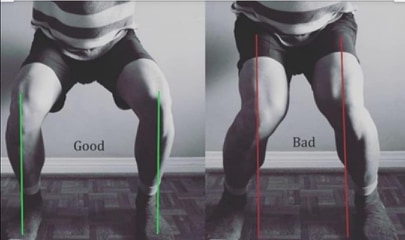When we are looking at injuries, shit does not happen, it happens for a reason that is governed by the laws of physics and controlled by functional anatomy (Michael Boyle). Knee valgus is believed to be a major contributor to noncontact ACL (anterior cruciate ligament) injuries.
Knee valgus also known as valgus collapse or medial knee displacement occurs when the knees cave inward. It results from a combination of femoral and tibial motions, which can be influenced by the joints proximal and distal to the knee, including the trunk, hip and ankle. Lack of femoral control can result in excessive adduction and internal rotation which can stress the ACL. Foot pronation and limited ankle dorsiflexion are also believed to influence knee valgus (Bell et al, 2013). Research supports that hip muscle strength plays a significant role in the control of frontal plane knee motion, thus it is of major importance to strengthen the hips when trying to avoid knee valgus (Hollman et al, 2013)
The ideal position of our knees is to be in direct alignment with the feet (knee-over toes). For example, during squats, the knee is considered to be unstable anytime its position deviates from this ideal alignment (Horschig, 2016).
Let’s see how we can apply theory into practice. First of all, correct technique is key to avoiding any injuries. For example, some people have never been shown how to squat correctly, therefore reinforcing bad technique i.e. knee valgus, which may lead to injury. https://vaiastrengthlab.com/blog/how-to-master-the-squat-and-stay-injury-free/
Another important area to address is any restrictions in hip mobility. Mobility refers to the amount of usable motion that one possesses across a particular joint. The more mobile a person is, the more they are able to maximize their movement potential safely, efficiently, and effectively. A great system of mobility and joint control training, known as FRC (Functional Range Conditioning), based on scientific principals and research, is a great tool to achieve that. Visit https://functionalanatomyseminars.com/ to learn more.
Next step is to incorporate exercises to improve hip stability & strength. Lateral band walks are great for strengthening the glute medius, which plays an important role in stabilizing the knee. Clamshells, standing hip abductions and single leg touchdowns, are some of my favorite exercises you can incorporate in your training. To find more about glute strengthening exercises read my article https://vaiastrengthlab.com/blog/7-glute-strengthening-exercises-you-should-start-doing/
My advice: the weight on the bar means nothing if our technique sucks. Stop lifting with your ego and focus on solid technique, instead. Be patient, start with the basics and progressively overload the movement, if you want to stay pain free! Safety comes first!
